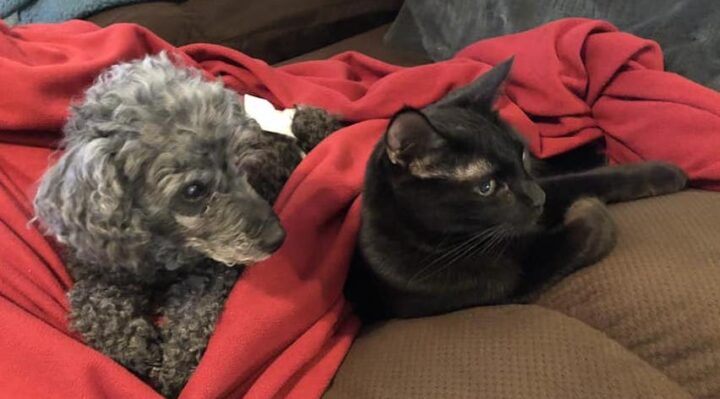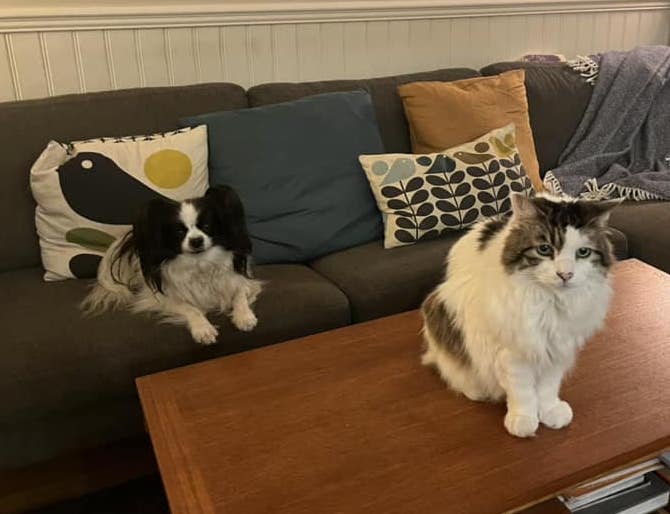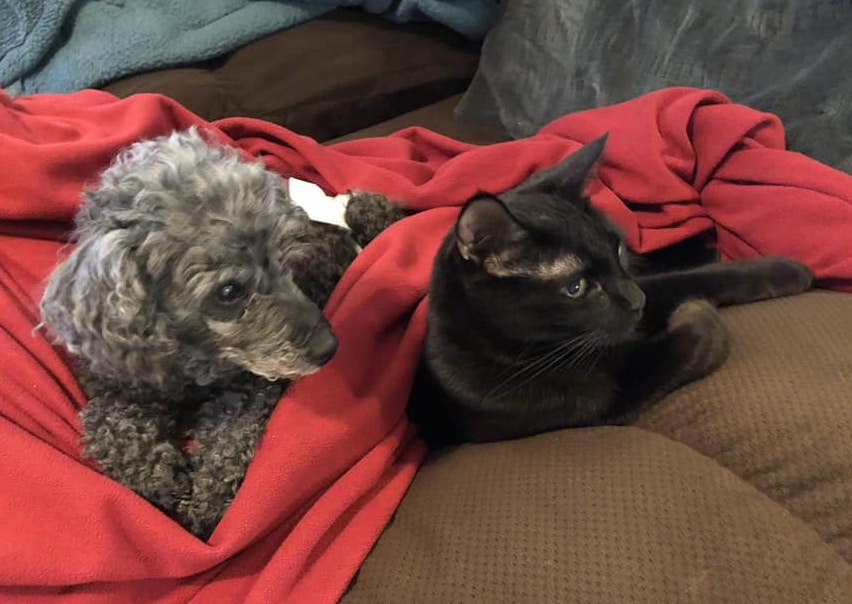
My friends will be bringing their new puppy home this month, to a house where two grown cats have been living—without a dog. Their situation inspired my question. I asked cat- and dog-loving friends online, “How can the human guardians wisely and safely introduce the cats to the puppy and the puppy to the cats? What would you suggest? What’s worked for you?”
Here are some of the suggestions that were shared in their answers:
Christina Rosa (Washington) Take it slow, so that neither animal walks away from any interaction having had a negative experience. Don’t be afraid to utilize gates, crates, and ex-pens for either animal. Better that both animals feel safe and secure in their environment during their first interactions.
Alisha Ardiana (California) Prevent any opportunity [for the pup] to chase the kitty. If [chasing the cat] becomes valuable [to the dog], it will be very difficult for you to provide any kind of meaningful intervention. I had two sets of gates set up, so the dog could never reach the cat. The cat was able to leap the baby gate, so she could get away if necessary. The cat was fed up high and could access food without crossing paths with the dog. The litter box was never available to the dog. Baby gates kept the dog from entering the bathroom, but the cat could jump over them. Meanwhile, start playing with lots of toys, tugs, flirt poles. You want to teach your dog that they have the ability to chase and catch toys, and not have the cat be the object of their desire.
Ex-pen or crate the puppy at night so they cannot chase the cat. Once you have prevented chasing, and the dog can be in the presence of the cat, keep the puppy occupied. Be looking for activities the dog can do in the cat’s presence. Chewing or licking, doing a puzzle toy or snuffle mat. We are always trying to find the right ratio.
It took us three months before the dog could hold it together in the presence of the cat. The dog was not allowed to be free at night until she was two.
I do not recommend letting them ‘work it out.’ I once made a mistake and the dog charged the cat. The cat swiped at the dog and narrowly missed lacerating an eyeball.
The goal is [for the animals] to coexist.
I also want to add that anxiety means you don’t know what’s going to happen and you don’t know what to expect. The solution is choice, control, and predictability. These animals did not choose to live with each other. Consequently, we need to give them as much control and predictability as possible. I personally would not recommend holding an animal so another animal can investigate. That does not offer a sense of control.
We also did not give the animals any opportunity to interact in our absence. To this day, we have gates that keep the dog in the kitchen when we are gone. And for the first several months, the cat was always locked in the bedroom/bathroom so she could not watch the dog while we were gone.

Photo by Alisha Ardiana
Jaxon Riley (Washington) Be patient. Proceed slowly.
Chellie Pixie Saunders (Ireland) I’ve done it for years. With an older kitty, use a cage and place it in a central place in the home. I did that with our Jaspurr, whom we adopted after my bro died. It wasn’t overnight with him, but after time they accepted each other. My Oscar and my Sadie are best friends.
Sandee Strobel Szabo (Virginia) We typically use baby gates to keep them separate. We do hold the cat and let the dog sniff, but if it seems to not be going well, we turn and walk away with the cat. We have also used a few different scent methods. We have taken a towel and rubbed the cat, then allowed the dog to sleep with the towel, and the reverse with the cat. We have done the same towel method with our own scent, giving the towels to both. We keep the baby gates up so that the cat always has an escape route, just in case.
Ali Blakney (Washington) 100% everything Alisha said! Couldn’t have said it better myself and I’m glad I didn’t have to. Just adding a picture of our beloved toy poodle, Lucy and one of our cats, Winston. They were the best of friends.

Photo by Ali Blakney
Jo Trent (West Virginia) As others have said, baby gates are great. My cats have their own room so when they want to get away, they have their space plus the basement. When Jelly was in her ex-pen, that’s when Monster would come investigate and check her out.
Micha Michlewicz (Maryland) Maintain space and escape options! Having the choice and ability to get away helps to produce less conflict and a more productive relationship. Use baby gates, cat trees, exercise pens, a clear path to another level of the house, etc. I’ve also found that realistic-looking stuffed cats [like those from Melissa and Doug], that look like your cat, can be very helpful for training the dog without having to stress your cat out. This allows you to place the [stuffed] cat at different places and even to move it past the dog, since movement will be the most exciting for the dog. If your dog can’t control itself, gently remove the dog from the room to calm down somewhere else, and try again later. Try to prevent things from getting to that point by observing body language and behavior to predict when the dog might have an outburst. In other words, don’t wait for the outburst to remove the dog! The goal of taking them away isn’t to punish, but to help them learn to be calmer around the cat—also to help them learn that going after the cat isn’t an option. Try to find the [furthest] distance away in your home to work with them. It may even be a staircase. It could even be outside, as long as you use a toy cat.
Marilyn Marks (Connecticut) Training sessions for “how to be around each other.” Dog and cat/s separated except when in training session; dog on leash whenever cat is out and about. Even five minutes at a time of successful, supported interaction with training input is better than at-will behavior and your trying to thwart chasing or other issues. Support, for me, would be what I call The Good Dog Game: yes/treat for any appropriate behaviors (chosen by the dog, not cued). Also, give [the dog] a bully stick or filled Kong when the cat is around. Both treats and chewy help make the cat NOT the center of attention.
Are you expecting to add a new puppy to a household that already has a resident cat or cats? Plan ahead, long before the puppy comes home, to decide where you will place and use barriers like ex-pens and baby gates. Set those barriers up now so that the cat/s can become familiar with them and relaxed around them. Consider where best to place the feline food and water stations and the litter box or boxes so they will be out of sight and out of reach of your future canine family member.



